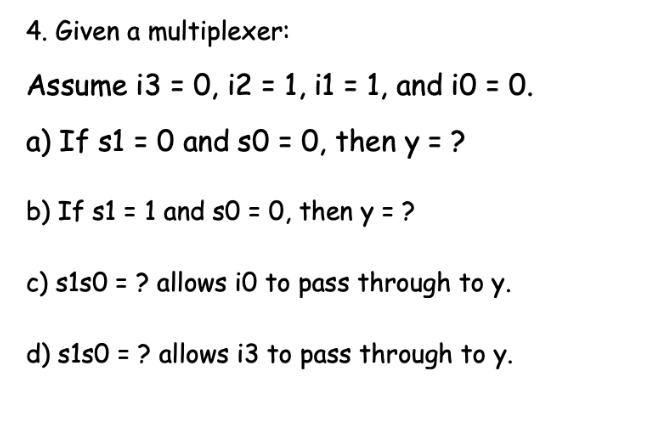4. Given a multiplexer: Assume i3 = 0, i2 = 1, il = 1, and iO = 0. a) If s1 = 0 and s0 = 0, then y = ? b) If s1 = 1 and sO = 0, then y = ? c) sls0 = ? allows iO to pass through to y. d) s1s0 = ? allows i3 to pass through to y.
4. Given a multiplexer: Assume i3 = 0, i2 = 1, il = 1, and iO = 0. a) If s1 = 0 and s0 = 0, then y = ? b) If s1 = 1 and sO = 0, then y = ? c) sls0 = ? allows iO to pass through to y. d) s1s0 = ? allows i3 to pass through to y.
C++ for Engineers and Scientists
4th Edition
ISBN:9781133187844
Author:Bronson, Gary J.
Publisher:Bronson, Gary J.
Chapter4: Selection Structures
Section4.3: Nested If Statements
Problem 8E
Related questions
Question

Transcribed Image Text:4. Given a multiplexer:
Assume i3 = 0, i2 = 1, i1 = 1, and i0 = 0.
a) If s1 = 0 and s0 = 0, then y = ?
b) If s1 = 1 and so = 0, then y = ?
c) s1s0 = ? allows i0 to pass through to y.
d) sls0 = ? allows i3 to pass through to y.
Expert Solution
This question has been solved!
Explore an expertly crafted, step-by-step solution for a thorough understanding of key concepts.
This is a popular solution!
Trending now
This is a popular solution!
Step by step
Solved in 2 steps

Knowledge Booster
Learn more about
Need a deep-dive on the concept behind this application? Look no further. Learn more about this topic, computer-science and related others by exploring similar questions and additional content below.Recommended textbooks for you

C++ for Engineers and Scientists
Computer Science
ISBN:
9781133187844
Author:
Bronson, Gary J.
Publisher:
Course Technology Ptr

C++ for Engineers and Scientists
Computer Science
ISBN:
9781133187844
Author:
Bronson, Gary J.
Publisher:
Course Technology Ptr